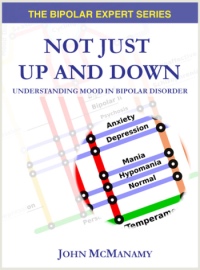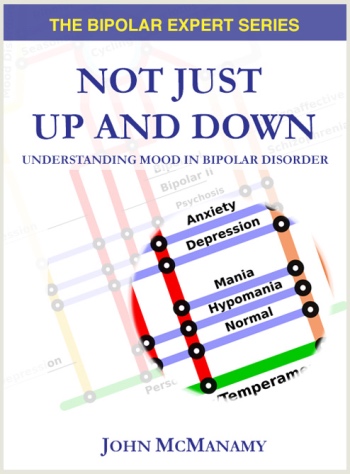Poisonality
 |
Everyone knows someone like Amy, but even Mother Teresa had her off-moments.
|
Personality disorders. Rewind a bunch of years ago. Bill treats his mom to a cruise.
Fast forward to the present. An aunt is being laid to rest. Bill's mom happens to mention the cruise to her daughter. As the casket is carried out, the daughter pulls her other brother aside and says in a voice quivering with rage, one that carries into the distant pews, “She really knows how to push my buttons!”
Everyone would agree that the daughter’s behavior is highly inappropriate, but is it consistent with a personality disorder? Consider:
Let’s suppose the daughter – call her Amy – had been especially close to her aunt and not so close to her mother. Suppose for two days, in her state of distress, she has been enduring a steady stream of sugar-coated insults from a mother she can barely stand. Then mom makes a seemingly innocuous comment that sets her off …
My New Book!

Purchase now.
Let’s change the context. This time, suppose Amy had to cross three time zones to attend her aunt’s funeral. She has missed a night’s sleep which has triggered an irritable hypomania. During the service, she is literally crawling out of her skin. The air is oppressive, the people are making her claustrophobic, she can’t sit still, she wants to scream. Her mother says something, and she turns to her brother …
Distinguishing a bad hair day from a mood episode from a personality disorder meltdown is notoriously difficult. Even Mother Teresa had her off-moments, and no doubt Gandhi had unresolved issues he needed to work through. We all have feet of clay. Labeling someone with a personality disorder, then, is perhaps the most insulting and stigmatizing act one can visit upon an individual, even in the name of therapy and treatment. Reflect for a second the names psychiatry has bestowed on the four main personality disorders, lumped together into what are called cluster B personality disorders: Borderline personality disorder, antisocial personality disorder, narcissistic personality disorder, histrionic personality disorder.
You are not supposed to like these people, is the strong message attached to these labels. These people are poison, the message goes on to say. They lack empathy, they are impulsive, and only they matter. The golden rule doesn’t apply to them and neither do most of the commandments and other people's personal boundaries. Cut them out of your life, run away, treat them like lepers
And you thought depression and bipolar disorder carried a terrible stigma. Then again, if a family member or an acquaintance or a colleague at work is currently making your life miserable, you probably don’t have much sympathy. Life is like that.
Psychiatry effectively divides mental illness into two major categories, or axes. Depression, bipolar disorder, anxiety, schizophrenia, and other “clinical” illnesses occupy Axis I while the personality disorders occupy Axis II (there are five axes in all). Axis I, to oversimplify, is about chemical imbalances, Axis II about unresolved emotional issues.
The DSM-5 (due out in 2013) will give personality disorders more respect by eliminating the Axis I/II distinction and will reduce diagnostic confusion by deep-sixing four of the ten current disorders.
We all have personality issues in abundance, and that is the term of choice for this writer. This is not about US and THEM. Usually, we are talking about WE. The labels psychiatry employs are useful only to a point. Yes, we may think we know a narcissist when we see one, but the human psyche is way too complex to allow for easy pigeonholing, even when performed by the experts. Moreover, in separating out various pathologies into discrete categories, we tend to overlook the dimensional aspect of personality, where various traits bleed across diagnostic boundaries. For the sake of getting a discussion going, we will start with the standard labels, but please keep in mind these are overly broad generalizations that most of psychiatry finds in bad need of reforming.
Borderline Personality Disorder
Freud's successors came up with this term to describe what they saw as problem patients bordering on psychotic. "Emotionally unstable" is a far more accurate description. Nevertheless, the label borderline stuck, together with the legacy of borderline individuals being regarded as problem patients. Sympathetic hospital staff have been known to turn on individuals in distress once they have been handed this diagnosis.
Borderline made its official debut in the DSM-III of 1980, but on the surface is very difficult to distinguish from bipolar. Unofficially, psychiatry is guided by the common stereotype of the moody and often hysterical teenage girl (or people who act like one) who may have abandonment issues, act impulsively, and engage in destructive behavior such as cutting. Twice as many females are diagnosed with the illness, possibly because problem males better fit the stereotype of antisocial personality disorder.
Susanna Kayson’s “Girl Interrupted” is the classic example of borderline personality disorder. Ms Kayson describes how she was shipped off to McLean Hospital outside of Boston back at a tender age in an era when she should have been attending Woodstock and going to college.
People living with someone who exhibits borderline tendencies typically describe the relationship as akin to walking on eggs: one minute all love and light, the next a hateful explosion or the sullen silent treatment. A borderline meltdown tends to have its roots in the individual’s lack of ability to handle the stress of any given social situation. Thus it can occur without warning. This tends to contrast with bipolars behaving badly, which typically flows in slower cycles.
(For more on borderline, check out my three articles beginning with Is Borderline Personality Disorder Real?)
Antisocial Personality Disorder
Serial killers generally fall into this class, but the diagnostic criteria is wide enough to include your abusive boss or scheming co-worker, or for that matter your brother who borrows your car and returns it without refilling the tank. According to the old joke, poor people with antisocial personality disorder are in prison, middle class individuals with this disorder are in therapy, and rich people with the label are CEOs. These are your classic sociopaths, out for number one, with no regard for others. “I’d walk over my own grandmother to re-elect Richard Nixon,” Watergate conspirator Chuck Colson once bragged. He wasn’t joking. He authored an “enemies list” of real and imagined political opponents to be singled out for special treatment, such as FBI harassment and tax audits.
Narcissistic Personality Disorder
We are not simply talking about over-inflated egos. Rather, the narcissist sees him or herself at the center of his or her own personal universe, with everyone else relegated to bit players assigned to specific minor roles. Dare to intrude reality into this individual's fantasy world and brace yourself for a narcissistic rage.
The first version of draft DSM-5 would have eliminated narcissism as a stand-alone diagnosis and consigned it to a feature of antisocial (the two share in common a pathological lack of concern for others). The second draft restored narcissism as a diagnosis by (it seems) popular demand.
But the closely-related histrionic personality disorder will become history by mid-2013. Generally, if a diagnostic distinction is too subtle for the general public to appreciate then it is not useful for clinicians, either. Is Tom Cruise jumping up and down on Oprah's couch a sign of narcissism or histrionism? Who knows?
Meanwhile, Back at the Funeral Service
Let’s return to Amy. She could be having a bad hair day. She could be experiencing a mood episode. She could also be having a meltdown stemming from various personality issues.
Please make careful note of the term, various personality issues. We are not going to attribute Amy’s outburst to one full-blown personality disorder. She may have one, she may not. But in all likelihood, a number of things are going on, a bit of this, a bit of that. Amy may be a kind and loving person, but her funeral theatrics indicate that something is clearly wrong.
But does Amy know it? She looks at the people staring at her and wonders what THEIR problem is, then leaves the church as if nothing happened. Or, if she acknowledges something has happened, she has already justified it – clearly it was her mother’s fault, the one who knows how to push her buttons. If her mother is a saint, if cornered, Amy will find a way to demonize her.
Woe to the person who may challenge Amy, but even if all her defenses are unmasked, she can still play the pity card. Even when she admits she’s wrong, the attention is worth it. There is victory in defeat.
Therein lies the difference between a person experiencing a bad hair day or mood episode and one with personality issues. The former are typically mortified by their out-of-character behavior (once they have settled down). When personality comes into play, the issue is far more complex. There may be no settling down; the behavior in question may be part of one's default setting (though change is possible). Or, there may be only a small window for remorse before Amy's world once again closes in on her, overwhelms her.
But before you congratulate yourself for not being like Amy, it pays to recall that we all have personality issues of some sort. And when a mood episode happens to join in an unholy alliance with one of our issues, well maybe people prefer Amy's company to yours or mine. Perhaps you can't spot when this happens, but you can pick up clear hints from friends and family. "Just snap out of it" and "chill out," are good indications that you need to work on your mood episode. A clear injunction to "get over it," on the other hand, suggests that a major behavior course correction may be your best option.
But Before We Start Judging Amy
Clinicians need a lot more to go on than a single incident. Typically, they look for a pattern. Okay, let’s play spot the pattern with Amy: Has told mom 15 years running that she is six months from submitting her novel manuscript - her friends call it the next Wuthering Heights - to a publisher; Has had fights with everyone who has tried helping her get her manuscript published; Says she will join an exercise program once she has submitted her novel…
Okay, we’re starting to pick up a pattern. But is it one that seriously impairs her life? She already has a secure and well-paying job. What about other aspects of her life, then, such as personal relationships? Her Wuthering Heights manuscript steams with hot sex, which she broadly hints to anyone who will listen is autobiographical, but her last fling was twenty years ago. She has never sustained a long-term intimate relationship, but then again she manages to attract a lot of friends. Granted, these friends may have to cut her a bit of slack, such as the time she abused and stiffed a waitress because she couldn’t order from the children’s menu. And they roll their eyes when she says she’s going to have her own show on the Food Network, but she’s just crazy enough to pull it off. After all, she’s a good friend of Rachel Ray’s, and she wouldn’t be saying that if it weren’t true, right?
Yes, Amy may have issues, but her ability to manipulate and intimidate and draw attention to herself, not to mention the supreme self-confidence she exudes, are exactly the right stuff for personal success. If only she weren’t quite so normal she could be on the cover of People magazine.
No, the real test is when she returns home to her empty condo, alone with her thoughts and vulnerabilities.
It’s later in the day, and the funeral party has gathered for eats in the church rec hall. Now Amy is making nice with the family. She tells her mother how good she looks and fusses appropriately over her three nieces. Okay, reaching for that second piece of cake after she just informed people of her diabetes may have raised eyebrows, but even cynical cousin Paula is flattered to hear they must “do lunch” sometime soon.
“I’m flying out to see a client tomorrow,” she lets everyone know, as if to apologize for her early exit. She doesn’t tell them that the “client” is really a Ponzi scheme artist out to separate her from her personal fortune. But the joke is on the Ponzi schemer. Little does he know that the personal fortune he has heard Amy refer to involves the film rights to her next Wuthering Heights, the one that has been in a state of near-completion for 15 years, the one that Steven Spielberg will be shooting any day now.
And I say to myself, what a wonderful world …
See also: Borderline Personality Disorder and The DSM-5 Gets Personal
April 22, 2006, last update Oct 13, 2011
 |
More articles on behavior. |




